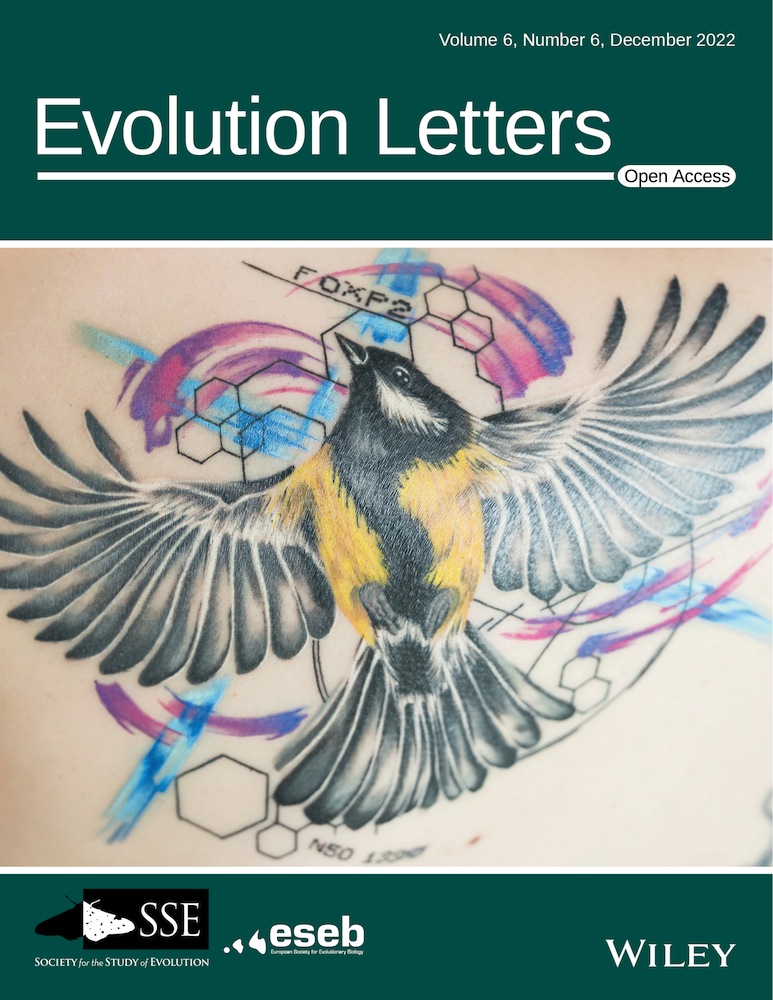通过寄生虫介导的选择维持寄主异交所需的高寄生虫毒力
IF 3.7
1区 生物学
Q2 EVOLUTIONARY BIOLOGY
引用次数: 0
摘要
摘要:双亲性行为在自然界中广泛存在,但相对于单亲生殖而言,其成本较高。通常不清楚为什么自交受精或无性生殖谱系不容易入侵异交种群。红皇后假说预测,共同进化的寄生虫可以防止自交受精或无性谱系入侵异交宿主种群。然而,只有高毒力的寄生虫才会保持异交,这可能限制了红皇后假说的普遍适用性。在这里,我们测试了共同进化的寄生虫在异交宿主种群中阻止自交受精入侵的能力是否依赖于寄生虫的毒力。我们将既能自花受精又能异交的野生型秀丽隐杆线虫(Caenorhabditis elegans)雌雄同体引入到固定于一个突变等位基因的秀丽隐杆线虫种群中。复制秀丽隐杆线虫种群在24代宿主中暴露于四种毒力不同的粘质沙雷氏菌寄生虫中的一种,在三种处理下:热灭(对照,非传染性)寄生虫处理,固定基因型(非进化)寄生虫处理和共进化(可能共同进化)寄生虫处理。正如预测的那样,在控制和固定寄生虫处理中,自受精侵入秀丽隐杆线虫宿主种群,而不考虑寄生虫的毒力。在共交处理中,自交入侵宿主种群与低至中毒力菌株共同进化,但在与高毒力菌株共同进化的宿主中仍然罕见。因此,我们发现只有高毒力的共同进化寄生虫才能阻止自交的入侵。本文章由计算机程序翻译,如有差异,请以英文原文为准。
High parasite virulence necessary for the maintenance of host outcrossing via parasite-mediated selection
Abstract Biparental sex is widespread in nature, yet costly relative to uniparental reproduction. It is generally unclear why self-fertilizing or asexual lineages do not readily invade outcrossing populations. The Red Queen hypothesis predicts that coevolving parasites can prevent self-fertilizing or asexual lineages from invading outcrossing host populations. However, only highly virulent parasites are predicted to maintain outcrossing, which may limit the general applicability of the Red Queen hypothesis. Here, we tested whether the ability of coevolving parasites to prevent invasion of self-fertilization within outcrossing host populations was dependent on parasite virulence. We introduced wild-type Caenorhabditis elegans hermaphrodites, capable of both self-fertilization and outcrossing, into C. elegans populations fixed for a mutant allele conferring obligate outcrossing. Replicate C. elegans populations were exposed for 24 host generations to one of four strains of Serratia marcescens parasites that varied in virulence, under three treatments: a heat-killed (control, noninfectious) parasite treatment, a fixed-genotype (nonevolving) parasite treatment, and a copassaged (potentially coevolving) parasite treatment. As predicted, self-fertilization invaded C. elegans host populations in the control and fixed-parasite treatments, regardless of parasite virulence. In the copassaged treatment, selfing invaded host populations coevolving with low- to mid-virulence strains, but remained rare in hosts coevolving with highly virulent bacterial strains. Therefore, we found that only highly virulent coevolving parasites can impede the invasion of selfing.
求助全文
通过发布文献求助,成功后即可免费获取论文全文。
去求助
来源期刊

Evolution Letters
EVOLUTIONARY BIOLOGY-
CiteScore
13.00
自引率
2.00%
发文量
35
审稿时长
10 weeks
期刊介绍:
Evolution Letters publishes cutting-edge new research in all areas of Evolutionary Biology.
Available exclusively online, and entirely open access, Evolution Letters consists of Letters - original pieces of research which form the bulk of papers - and Comments and Opinion - a forum for highlighting timely new research ideas for the evolutionary community.
 求助内容:
求助内容: 应助结果提醒方式:
应助结果提醒方式:


